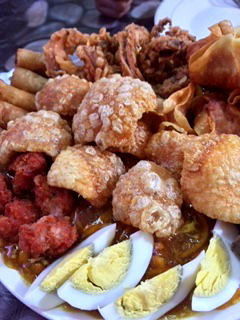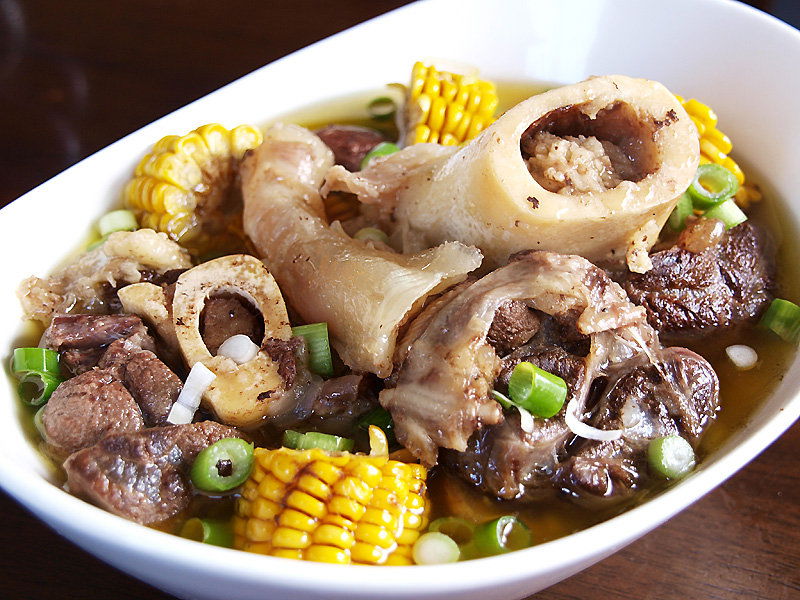Batangas Best Cuisine
Join us as we explore the dishes that warm the soul and bring people together—because in Batangas, food is more than just a meal; it’s a celebration of life and community.

LOMI
Lomi is a popular noodle dish in Batangas, characterized by its thick, savory soup and chewy, egg-based noodles. It is commonly topped with a variety of ingredients such as pork, liver, kikiam, fish balls, and boiled eggs, and is thickened with cornstarch or flour. Often garnished with spring onions, fried garlic, and sometimes a hard-boiled egg, it is typically served with calamansi, soy sauce, and chili on the side for added flavor.
Origin of Lomi in Batangas
Lomi was introduced to Batangas by Chinese immigrants in the mid-20th century. The dish quickly gained popularity due to its hearty and affordable nature, which resonated with the local community. It was first served in simple eateries and carinderias before becoming a signature dish in the province. Over time, Batangueños adapted the recipe, adding unique local touches, such as a richer soup base and a variety of toppings, to cater to Filipino tastes. Today, Batangas lomi is a culinary icon, often associated with comfort food and communal gatherings.

BULALO
Bulalo is a traditional Filipino soup dish made from beef shanks and bone marrow, slow cooked until the meat becomes tender and the marrow flavorful. The broth is clear but richly flavored with onions, garlic, peppercorns, and fish sauce, and more often than not paired with leafy vegetables like cabbage or pechay, corn on the cob, and potatoes. It is best enjoyed hot, making it a comforting meal, especially on cool days.
Origin of Bulalo
Bulalo is from Southern Luzon, or more specifically, Batangas and its neighboring provinces, for the fact that cattle farming is a familiar occupation. It became well-liked because it utilizes accessible and reasonably priced cuts of beef like shanks and bones that produce a hearty and flavorful broth. With time, the province of Batangas became well-known for this dish of bulalo, prepared with its rich, savored broth and tender meat to boot. It is often associated with roadside eateries and specialty restaurants in Batangas, where it remains a beloved culinary staple.

KAPENG BARAKO
Kapeng Barako is a species of vibrant coffee from the liberica genus. Characterized by its large bean size and bold flavor, the Kapeng Barako naturally grows in the Philippines-specifically, specifically in Batangas and Cavite. As such, it has traditionally been connected with the ordinary Filipino culture of drinking coffee.
Kapeng Barako was introduced to Batangas during the Spanish colonial period and soon became widely cultivated because of the ideal soil and climate of the province. The name "Barako," which means "stud" or "wild boar" in Filipino, speaks volumes about its strong and robust characteristics. It gained prominence as a staple coffee variety in the region and remains a symbol of Batangas' heritage.
Kalye Barako Brew Coffee Trading

SINAING NA TULINGAN
Sinaing na Tulingan is a traditional Filipino dish originating from Batangas. It features tulingan (mackerel tuna) that is slow cooked in a clay pot (palayok) with layers of dried Kamias (bilimbi) or sometimes vinegar as a souring agent. The fish is typically wrapped in banana leaves to enhance flavor and cook over low heat for hours, resulting in tender meat and a rich broth.
This culinary tradition dates back to when fishing was a primary livelihood in the region. With surplus fish catches, preserving them in a flavorful way became essential. Over time, sinaing na tulingan became a staple in Batangas households, valued for its simplicity, longevity, and distinct sour-savory taste.
